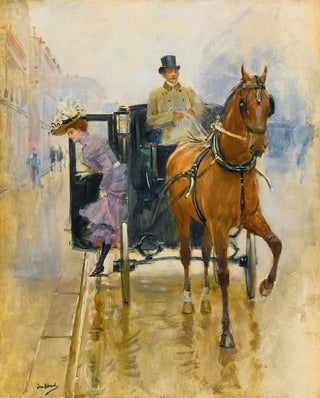Art print | Young woman descending from a fiacre - Jean Béraud


View from behind

Frame (optional)
Art print Jeune femme descendant d'un fiacre - Jean Béraud – Captivating introduction
In the vibrant world of 19th-century French art, the work "Jeune femme descendant d'un fiacre" by Jean Béraud stands out for its ability to capture the very essence of urban life. This painting, which depicts a scene from daily life in Paris, transports the viewer to a fleeting moment frozen in time. Through the gaze of this young woman, the artist invites us to explore the subtleties of social interactions and the emotions emanating from this simple descent from a fiacre. The soft light bathing the scene and the meticulous details of the Parisian decor create an atmosphere that is both familiar and imbued with mystery, encouraging contemplation.
Style and uniqueness of the work
Jean Béraud, master of the genre of modern life painting, succeeds in blending realism and impressionism in this iconic work. Béraud's style is characterized by a keen attention to detail, a sharp sense of composition, and a delicate color palette. In "Jeune femme descendant d'un fiacre," the textures of the clothing, the movement of the hair, and the facial expression of the protagonist are rendered with remarkable precision. The artist skillfully plays with light and shadow, creating a depth that brings the canvas to life. This ability to seize the present moment, to immortalize a fleeting emotion, makes Béraud an attentive observer of his time, capable of transcending the everyday to create a true work of art.
The artist and his influence
Jean Béraud, born in 1849 in Paris, is often regarded as one of the greatest painters of Parisian life. Influenced by the artistic currents of his era, he developed a unique style that combines realism and sensitivity. Béraud drew inspiration from urban life, from lively cafes to strolls in the gardens, including street scenes. His work reflects not only the beauty of the City of Light but also the social and cultural dynamics of the late 19th century. As a member of the Société des Artistes Français, he contributed to redefining genre painting by highlighting subjects

Matte finish

View from behind

Frame (optional)
Art print Jeune femme descendant d'un fiacre - Jean Béraud – Captivating introduction
In the vibrant world of 19th-century French art, the work "Jeune femme descendant d'un fiacre" by Jean Béraud stands out for its ability to capture the very essence of urban life. This painting, which depicts a scene from daily life in Paris, transports the viewer to a fleeting moment frozen in time. Through the gaze of this young woman, the artist invites us to explore the subtleties of social interactions and the emotions emanating from this simple descent from a fiacre. The soft light bathing the scene and the meticulous details of the Parisian decor create an atmosphere that is both familiar and imbued with mystery, encouraging contemplation.
Style and uniqueness of the work
Jean Béraud, master of the genre of modern life painting, succeeds in blending realism and impressionism in this iconic work. Béraud's style is characterized by a keen attention to detail, a sharp sense of composition, and a delicate color palette. In "Jeune femme descendant d'un fiacre," the textures of the clothing, the movement of the hair, and the facial expression of the protagonist are rendered with remarkable precision. The artist skillfully plays with light and shadow, creating a depth that brings the canvas to life. This ability to seize the present moment, to immortalize a fleeting emotion, makes Béraud an attentive observer of his time, capable of transcending the everyday to create a true work of art.
The artist and his influence
Jean Béraud, born in 1849 in Paris, is often regarded as one of the greatest painters of Parisian life. Influenced by the artistic currents of his era, he developed a unique style that combines realism and sensitivity. Béraud drew inspiration from urban life, from lively cafes to strolls in the gardens, including street scenes. His work reflects not only the beauty of the City of Light but also the social and cultural dynamics of the late 19th century. As a member of the Société des Artistes Français, he contributed to redefining genre painting by highlighting subjects






